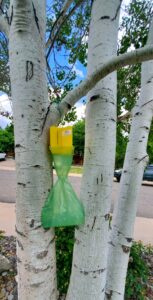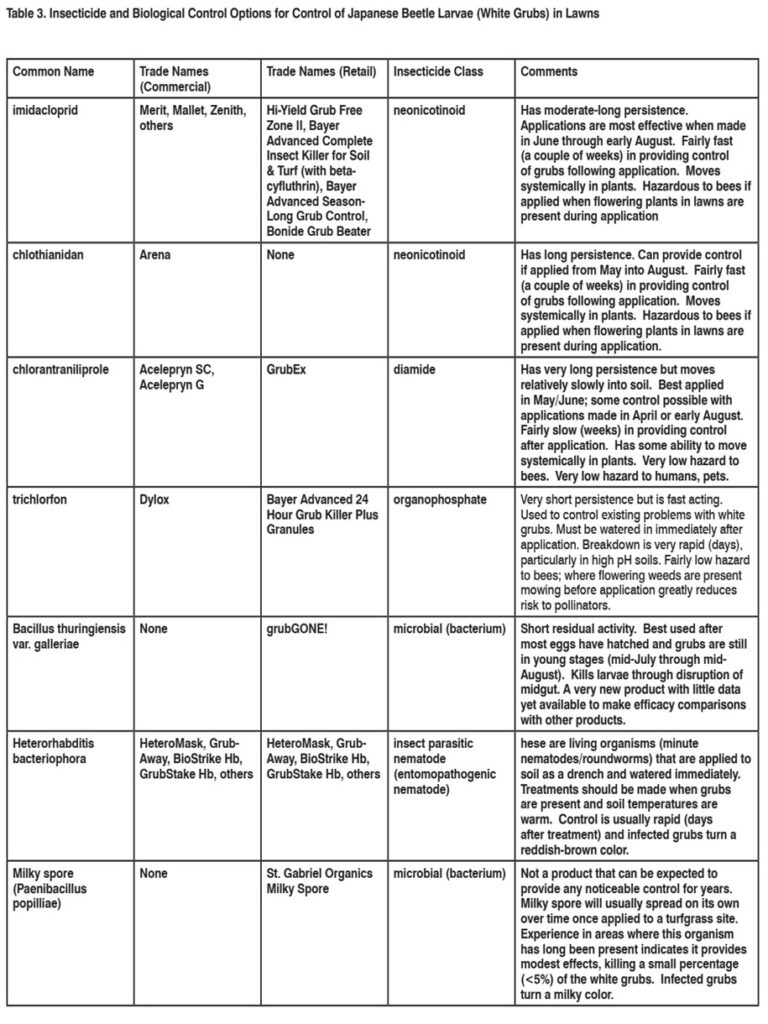Give Consent To Put a Trap On Your Property
If you are in an area where Japanese beetles have been detected and you received a postcard requesting consent to trap on your property.
Click the image below
JB Detected:
In mid-July 2022, an invasive insect known as the Japanese beetle (Popillia japonica Newman) was detected by the Colorado Department of Agriculture within Grand Junction city limits. The known impacted area spreads over four miles from Canyon View Park to Bookcliff Country Club, with the epicenter being multiple subdivisions near 26 Road. 239 adult beetles were captured.
Japanese beetles damage plants in both the adult beetle stage and in the immature white grub stage. The progressive life stages of the Japanese beetle during that period are egg, larva (white grub), pupa and adult. Adults are strong flyers with travel occurring up to five miles to find desirable plants to consume and they feed communally which can increase damage.
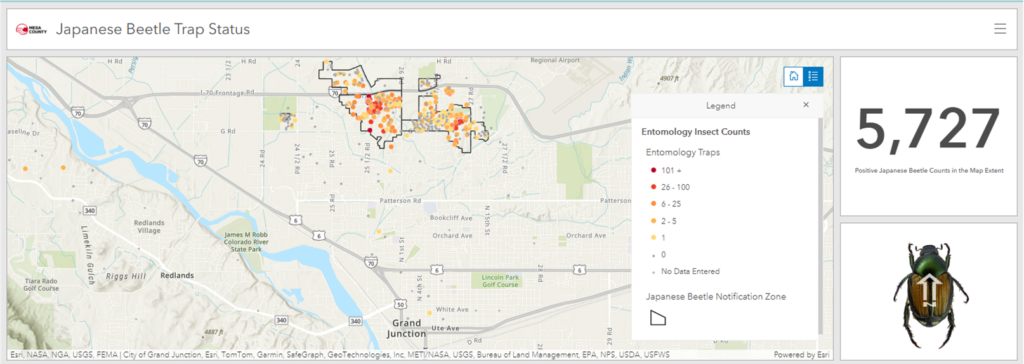
Map created by Mesa County GIS. Trap data collected by the Colorado Dept. of Agriculture.
History in the US:
The Japanese beetle is a native insect to Japan. The first detection of it in North America occurred in New Jersey around 1916 when larval stages of the insect were accidentally brought in on a shipment of nursery material from Japan for the World’s Fair. Within a few decades after its discovery, Japanese beetles have successfully spread across most of the eastern and Midwestern United States. Click the link to see a map of JB distribution in the U.S.
An Invasive Insect:
Invasive insects, like the Japanese beetle, are non-native organisms whose introduction can cause harm to the environment or economic interests. Early detection and rapid response often reduce the chances invasive insects, like the Japanese beetle, have to cause significant damage and become widely established. Since invasive species are in a new environment, free from natural predators, parasites, or competitors, they often develop large population sizes very rapidly.
Host Plants and Damage (Adults):
Japanese beetles are polyphagous, feeding on many types of plants. They also feed above ground primarily on all parts of the plants. Leaves are skeletonized, flowers are destroyed, and fruits are damage. Damage by adults is well documented on commonly grown ornamental and crop plants including: roses, holly hock, Virginia creeper, grape, peach, crab apples, little leaf linden trees, and multiple vegetable crops to name a few favorites.
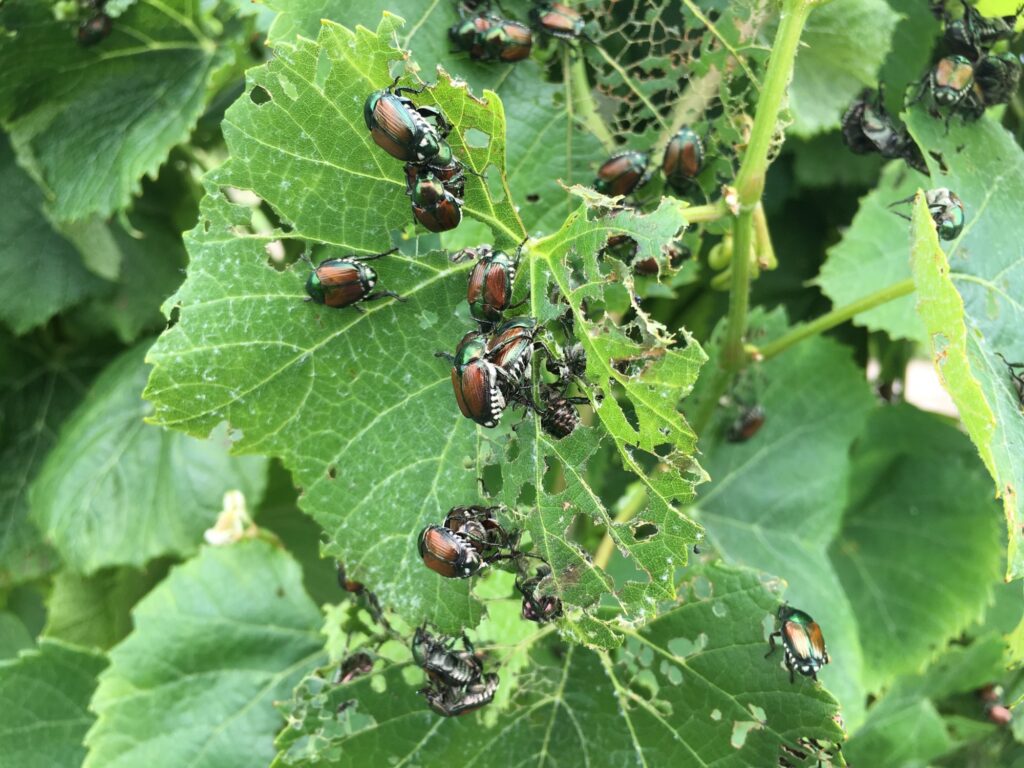
Photo from Purdue University.
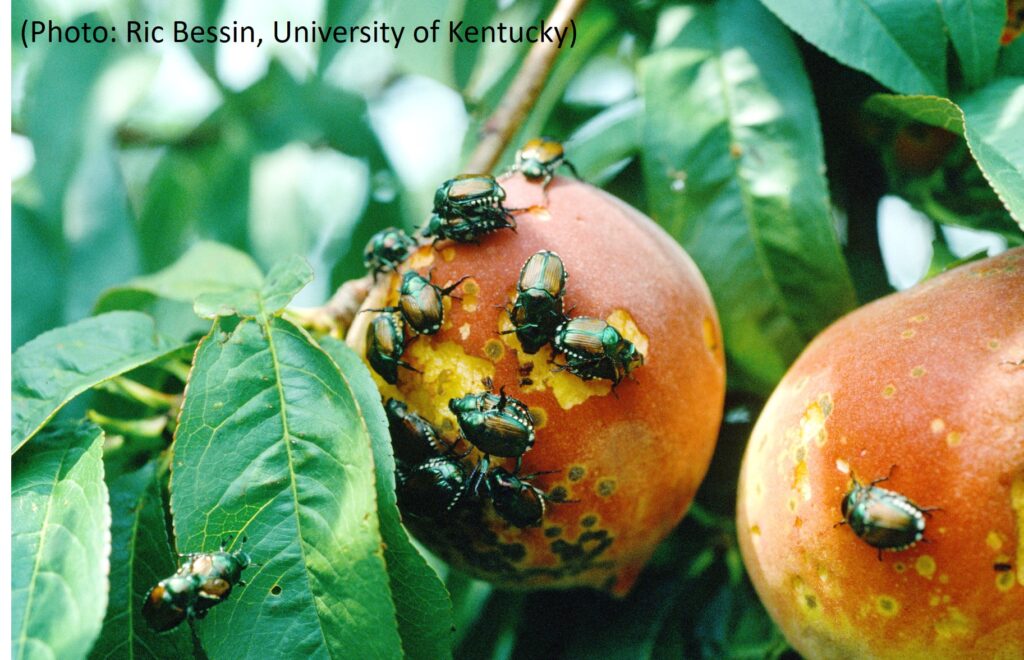
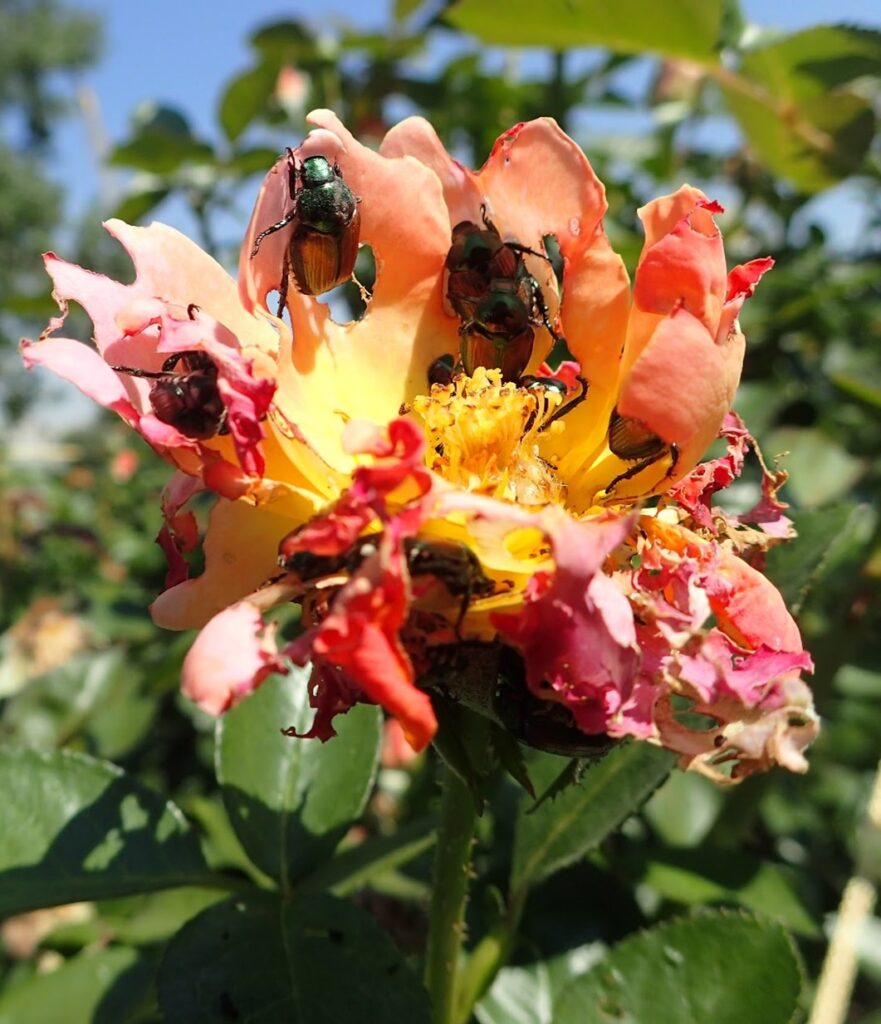
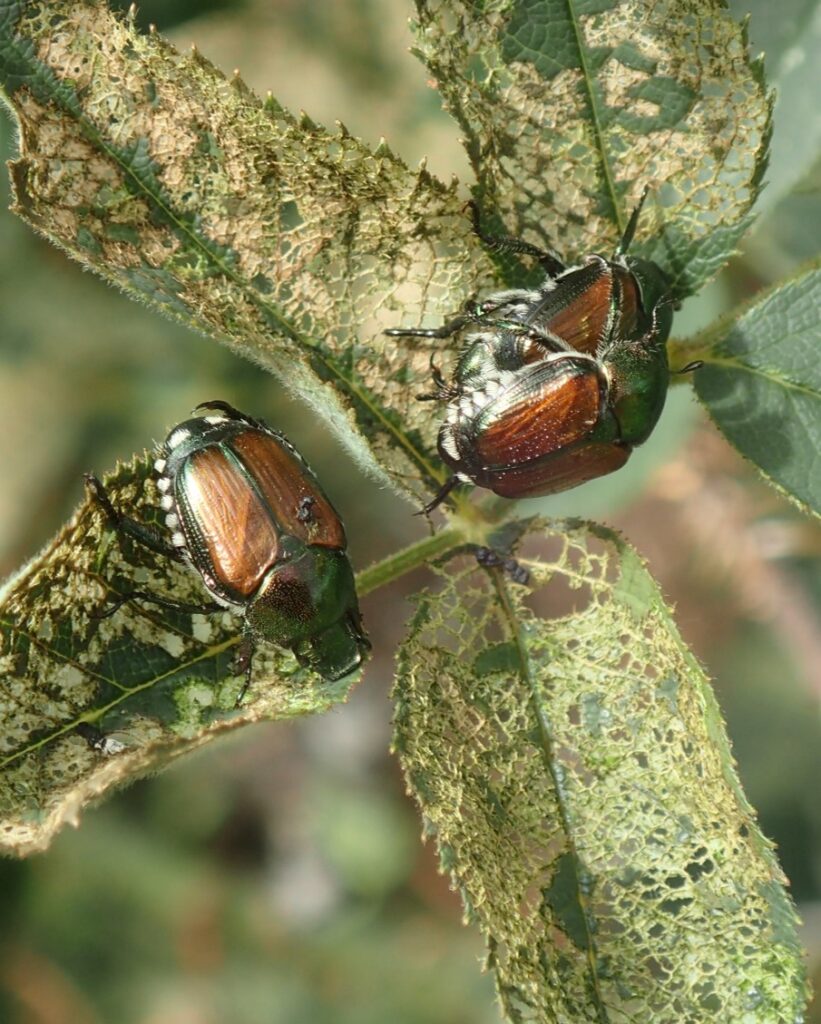
Host Plants and Damage (Larvae):
Japanese beetle larvae feed on roots of irrigated grasses and these injuries produce root pruning that limit the plant’s ability to acquire water. Cool-season grasses like Kentucky bluegrass, ryegrass and fescue are their preferred turf for egg laying. Damaged areas of turf grass are more susceptible to water stresses and severely pruned roots can lead to plant decline/death. Lavae are the stage that is best to be targeted for successful control efforts. We cannot predict exactly how the Japanese beetle will behave in the Grand Valley; severity and presence will be determined largely by the abundance of irrigated turf grass.
It is possible for Japanese beetle larvae to feed also on the roots of potted plants. If the potted plant material contains moist soil or organic matter that is attractive to Japanese beetle larvae, they may infest the plant and feed on root material. In turn, moving potted untreated plant material along the I70 corridor is risky since Japanese beetle larvae can be unintentionally moved back and forth. Japanese beetles are only able to cross over the continental divide, a natural and large geographic barrier, by unintended transportation by people.
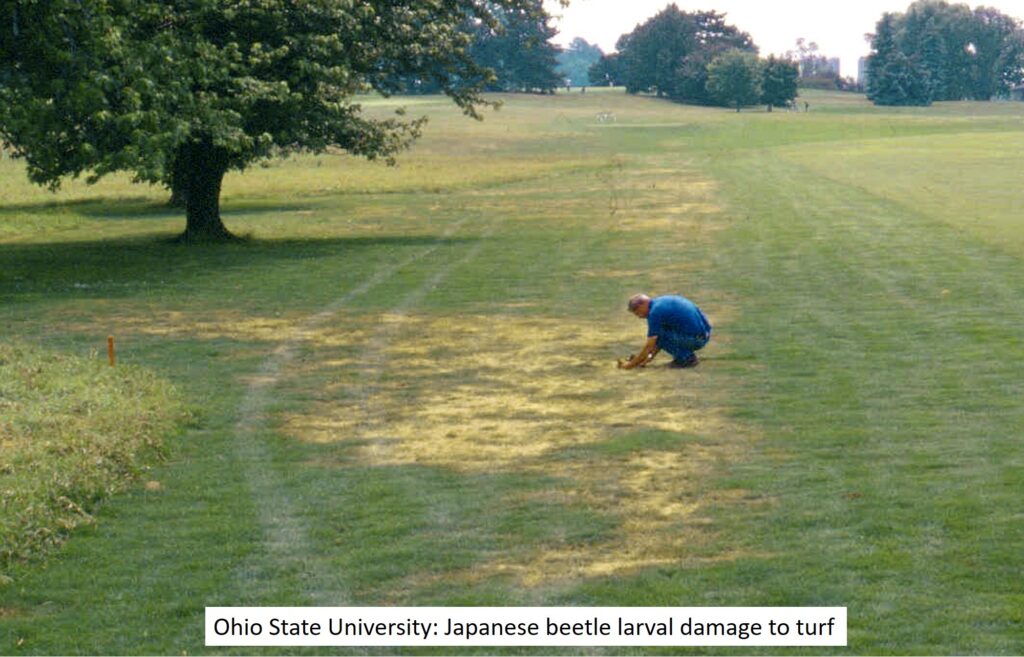
Japanese Beetle Life Cycle:
Through winter the Japanese beetle is in the larval stage, a white grub found within soil. Larvae will move up to begin feeding on plant roots, mainly irrigated turf grass, once soil temperatures increase. After completing their feeding stage, the grubs will enter their transformation stage and pupate. When larvae complete metamorphosis, adults begin to emerge from the soil in early June and are usually most abundant in early summer – from late June through August. There are one generation of Japanese beetle adults per year that emerge in the summer and feed on various plants across the landscape. As adults, Japanese beetles can be found feeding and mating on foliage and flowers of their many host plants. Prioritized egg laying spots will be neighborhood lawns, turf grass in parks, and golf courses/country clubs (areas of suitable moist turf grass to lay eggs). Once eggs hatch, the new generation grubs begin to feed for a period of the late summer/early fall before returning deeper into the soil to survive the winter.

Treatment (Adults):
Trapping (Pros)
- Setting out traps is easy. Adults are trapped by using a highly attractive dual lure (sex pheromone and floral lure).
- Trapping is a way to reduce adult numbers and feeding damage.
- It is very useful as early detection in an area where Japanese beetles are not present.
Trapping (Cons)
- Beetles can be spread to new areas cause they can be drawn to the traps from a great distance.
- Yellow tops are also attractive to bees.
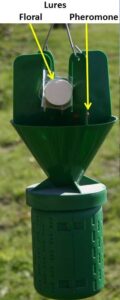
Video?
Hand Picking-In a small area hand picking beetles from plants can be effective at reducing adult damage. Early morning when temperature are cool is ideal. Plants can be shaken over a container to collect and dispose of these unwanted pests.
Insecticides-
ALWAYS READ AND FOLLOW LABEL DIRECTIONS
The label is the law.
As with every pesticide application, applicators must read and carefully follow all instructions on the Environmental Protection Agency (EPA) pesticide label, which includes the recommended dosage, application methods, and safety precautions, etc.
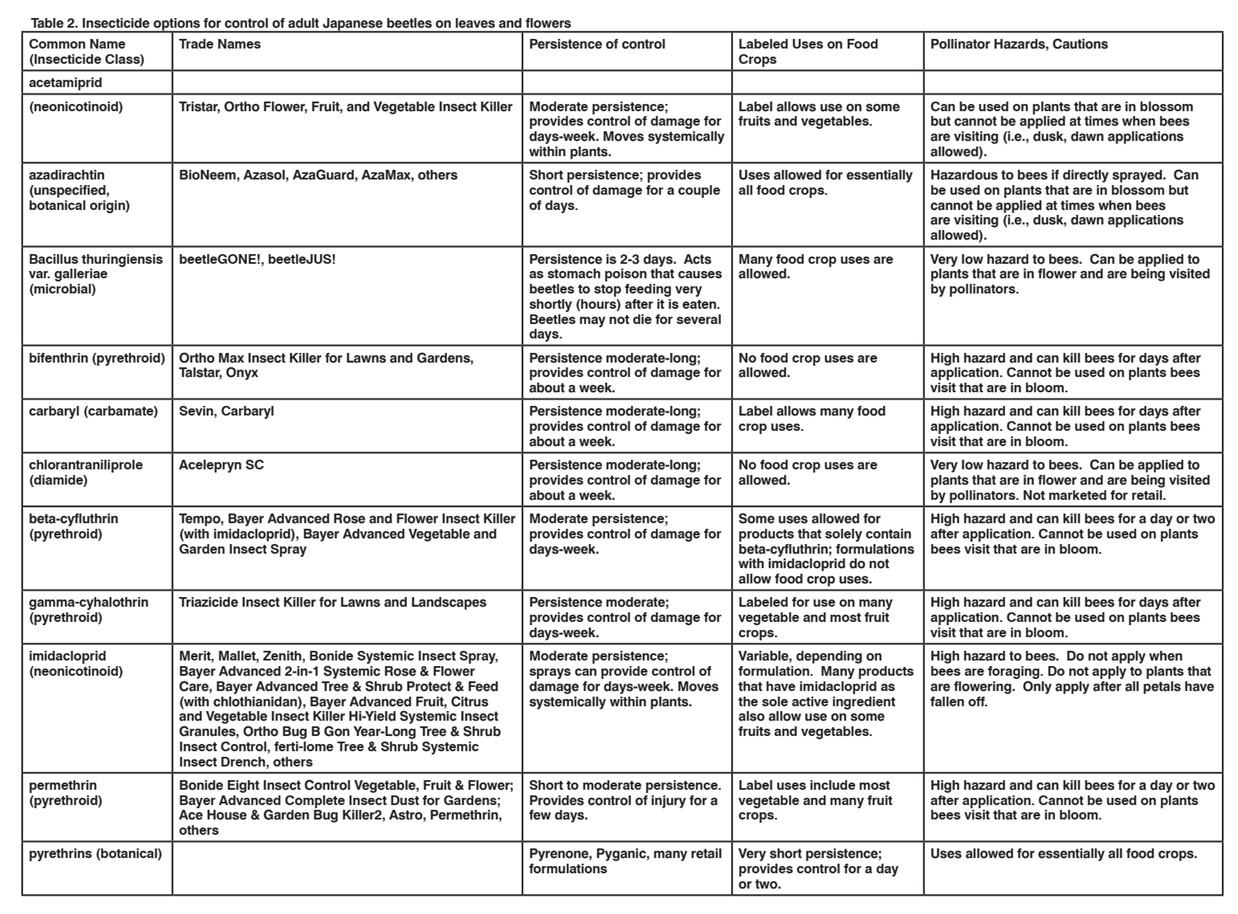
Treatment (Larvae):
There are multiple approaches for treatment of Japanese beetle larvae. The table below lists the products
ALWAYS READ AND FOLLOW LABEL DIRECTIONS
The label is the law.
As with every pesticide application, applicators must read and carefully follow all instructions on the Environmental Protection Agency (EPA) pesticide label, which includes the recommended dosage, application methods, and safety precautions, etc.
Mesa County and CSU Extension Tri-River Area are recommending insecticides with the active ingredient chlorantraniliprole to manage larvae of Japanese beetle in turfgrass. Insecticides with this active ingredient have long persistence and very low hazard to humans, pets, and bees.
- Scotts® GrubEx® is a granular product available for purchase without a pesticide license and may be used on residential lawns once per year.
- Acelepryn is a product available only to licensed pesticide applicators.
- Mow grass immediately before treating.
- Apply to dry lawn.
- Aerating lawns prior will not impact treatment negatively, it may even help the chemical reach the root zone.
- Irrigate turf immediately after application to move the product into the soil. Do not over-irrigate. Lawn watering guide.
Applications made from April to end of May are effective for three months in the soil against the upcoming season of Japanese beetle eggs and young instars.
Preferably, when treating Japanese beetle larvae, either a commercial turf care provider can be hired to apply labeled sprays/granular insecticides OR homeowners have the option to buy various products at their local retail provider and apply themselves (GrubEx contains the same active ingredient as acelepryn).
One last option would be to deprive the lawn completely from all irrigation water to be “dried down”. The grass must be completely free of moisture so any active grubs would die; dry grass would also not be a favorable egg laying site to adults. Unexpected precipitation complicates the efficacy of this approach.
Japanese Beetle Identification & Look-A-Likes:
Click to view this document for Japenese beetle ID and many other look-a-likes.
There are several insects that look similar to the Japanese beetle. If you think you have found a Japanese beetle adult or larva, please confirm the identification with CSU Extension entomologist, Melissa Schreiner, by calling the Japanese beetle phone tree 970-248-7000 ext. 3.
For more information please read Colorado State University Fact Sheet 5.601, Japanese Beetles.


